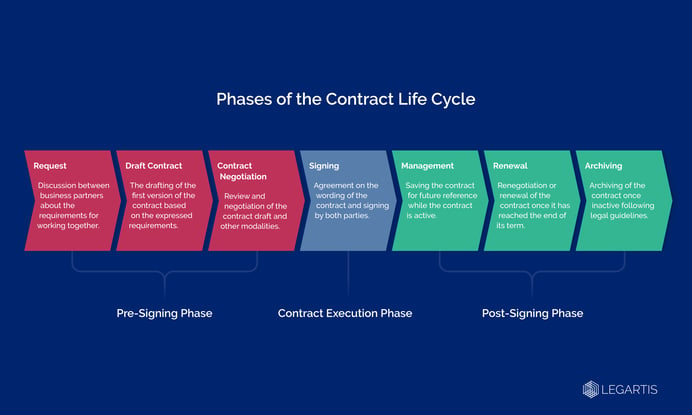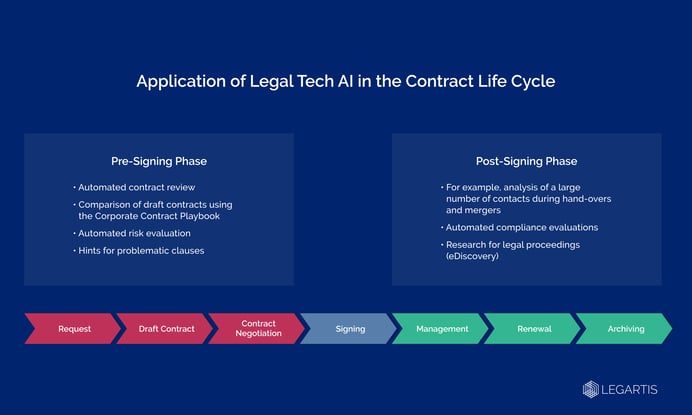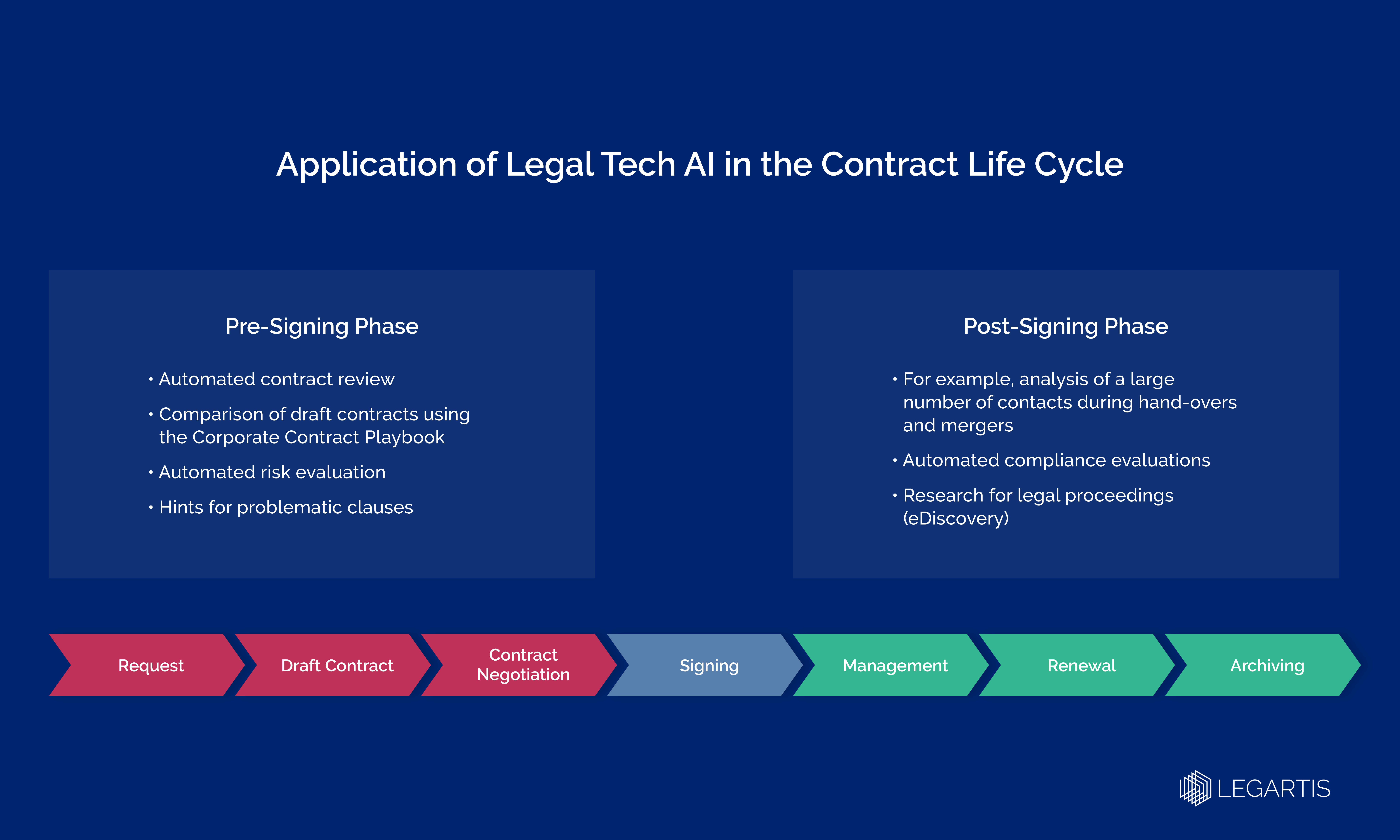As a heavily text-based discipline, the legal sector is made for the implementation of legal tech AI. There are many reasons why companies are sometimes hesitant to implement new technologies: cost reservations, scepticism about the user-friendliness and quality of AI applications, or fears of lawyers who see AI as competition. However, legal tech AI really just offers the opportunity to increase efficiency and productivity in the legal department.
In this article, we explain the use cases for legal tech AI, the technology hiding behind the buzzword, and how companies can capitalise on the potential of legal tech AI for their contract review.
Definition: the Contract Life Cycle
In the context of contract review, two terms keep coming up: contract life cycle and contract life cycle management (CLM). Although CLM has contract management in the word, the term has become known as referring to the software that supports contract management processes. The contract life cycle describes precisely these processes.
The term contract life cycle refers to the fact that a contract goes through many processing steps, from drafting to negotiation, until it is signed and finally stored. Lawyers have various possibilities available to them to organise or use technology to support the processing of these individual steps.
To understand how companies can implement software effectively, let's take a look at the different steps of the contract life cycle.

Stages of the Contract Life Cycle
The processing of a contract can be divided into three phases: the pre-signing phase, the contract execution phase and the post-signing phase. A phase may include several process steps. Often, there are seven distinguished steps in any contract life cycle:
- Demand: Business partners agree on contract negotiations and gather all necessary information to draft a contract that meets the mutual requirements for the collaboration.
- Contract drafting: One of the business partners draws up a draft contract based on the expressed requirements.
- Contract negotiation: The business partners review the draft contract, for example for its compliance with company guidelines and legal risks. Subsequently, both parties negotiate specific clauses of the draft and further contractual modalities.
- Signing: If both parties agree on the wording of the contract, the actual signing takes place. This can be done electronically or similar.
- Management: The contract is stored in an easily accessible way for future reference during the contract period.
- Renewal: When the contract reaches the end of its term, it is renewed or renegotiated.
- Archiving: When the contract is no longer active, it is archived in accordance with legal requirements, usually in a document management system.
Legal tech provides support in each of these phases; and in fact in some, the use of artificial intelligence is already promising and possible today.
Definition: Legal Tech AI
What exactly is behind the buzzword “legal tech AI”? We presented how legal tech can be defined in an article on the definition of legal tech. Legal tech AI is a subcategory of legal tech that describes applications which use artificial intelligence. However, the term AI (artificial intelligence) can create false expectations.
Legal tech AI does not refer to applications that can independently learn about arbitrary legal topics and develop solutions to legal problems. This form of human-like intelligence is called general AI and is, so far, pure fiction.
What is now referred to as artificial intelligence and is also what’s behind legal tech AI is Narrow AI: software that performs services in a narrow subject area that previously required human intelligence.
Legal tech AI refers to applications that combine various machine learning algorithms and, with the help of Natural Process Learning, are able to independently process legal documents in a narrow legal task area based on specifications and learn from their mistakes.
 The Elements of Legal Tech AI
The Elements of Legal Tech AI
The fundamental methods that contribute to the "intelligence" of legal tech applications are Natural Language Processing and Machine Learning.
Natural Language Processing (NLP)
Natural Language Processing enables computers to understand spoken or written language. A particular challenge here is the ambiguity of language. This is because, unlike humans, computers are not able to interpret sentences based on their experience and considering their context. Reading is therefore an extremely complex process for computers, and the development of NLP algorithms and rules is very demanding.
Machine Learning
Smart algorithms, which fall under the artificial intelligence category, are able to optimise their performance on their own. In other words, they can learn from their mistakes. This process is called machine learning. There are two types of machine learning: supervised learning and unsupervised learning. In supervised learning, humans must manually correct incorrect results from the system and in this way train the AI. In unsupervised learning, the system improves its performance on its own.
Legal tech AI is gradually finding its way into many areas of everyday legal work. The efficacy of AI support differs depending on the software and use case.
Applications of Legal Tech AI
Legal Tech AI works by means of the latest intelligent analysis methods: NLP and machine learning. For this reason, the applications develop their full potential when they support lawyers in text analysis.
Legal Tech AI in the Contract Life Cycle
AI applications used throughout the contract life cycle are either pre-trained or require a preliminary training phase implemented directly within their area of application before they can be utilized by users. The disadvantage of non-pre-trained AI applications is that it takes a relatively long time for the applications to be aligned with corporate policies. Pre-trained applications, on the other hand, can be used from day one.
It is fully possible that these applications can be used in every phase of the contract life cycle. However, legal tech AI achieves its greatest corporate effect in the pre-signing phase, which is where corporate risks can be reduced most effectively and productivity can be measurably increased with the help of these applications.

In the pre-signing phase, lawyers can use legal tech to support them in their research when drafting contracts. With the help of these applications, documents can be searched through in much more detail than with previous methods, which were often limited to titles or keywords.
When lawyers receive draft contracts, they no longer have to review them manually, but they can leave the contract review to the AI. The applications are able to compare draft contracts against Corporate Contract Playbooks, carry out automated risk analyses and provide information on problematic clauses. Lawyers can concentrate on the highlighted passages instead of going through documents sentence by sentence, saving an enormous amount of time.
Legal Tech AI is also increasingly used in the post-signing phase of the contract life cycle, for example to analyse a large number of contracts in the case of acquisitions and mergers, to carry out compliance checks, or to simplify research for legal proceedings (eDiscovery).
Use Case: Legal Tech AI in Contract Review
A fantastic example of how companies can integrate Legal Tech AI into their everyday business with measurable success is Schnellecke, a medium-sized logistics company that decided to introduce an automated contract review in 2021.
In light of growing global competition, financial pressures had risen continuously in recent years. Not only did the core areas of the company have to strive for process optimisations, but also the supporting functions, such as the legal department, were faced with the challenge to adapt their ways of working.
The legal department had heard about new applications based on AI technology and proactively looked for a solution that could speed up contract review. This was because they had to invest an excessive amount of work hours doing so. They chose Legartis because this solution can be seamlessly integrated into their usual work processes and existing word processor, and the artificial intelligence achieves very good results from day one. This is possible because it comes to the customer already pre-trained.
Schnellecke now has non-disclosure agreements automatically reviewed for compatibility with its own corporate guidelines. The two most important advantages: The check itself is completed in a fraction of the time it used to take when done by hand and it can be carried out directly in the department by non-lawyers. These first real-life applications are encouraging: in the future, other types of contracts will be checked automatically too.
 Legal Tech AI: 3 Key Takeaways
Legal Tech AI: 3 Key Takeaways
- Legal tech AI is an umbrella term for various technologies that work together to simulate human intelligence. The two most important technologies are Machine Learning and Natural Language Processing. Unlike other legal tech solutions, these applications learn from their mistakes and improve their performance over time.
- In recent years, more and more legal tech AI solutions are coming onto the market. The greatest business potential currently lies in their place in the pre-signing phase of the contract life cycle, in contract review and contract drafting.
- Legal Tech AI enables companies to optimise every step of the contract life cycle and speed up formerly time-consuming manual review work. This way, in-house counsel are relieved and workflows throughout the company can be optimised.
Legal tech AI enables non-lawyers to review important contracts themselves in just a short amount of time. Given the increasing workload in legal departments, other departments no longer have to wait long for review results. Ultimately, automated contract review enables companies to close new contracts faster and drive growth upwards.
Legartis has developed an AI-based solution for automated contract review that delivers a fast return on investment and integrates seamlessly with existing work processes. Are you interested in a non-binding demo of Legartis? Then get in touch with us.
Recommended Articles
Agentic Legal AI: When AI Shifts from Assistant to Actor
The days when AI in the legal industry was little more than a glorified spell checker are over. What sounded like science fiction just a few years ago is now reality: Agentic..
Agentic AI: Automated Generated Contract Playbooks
Every day, countless agreements are drafted, negotiated, and signed. For legal departments, legal-ops teams, and procurement leads, it is essential to keep track: Which..
Trends 2025: AI in Contract Analysis
The latest trends in Large Language Models (LLMs) show a shift towards greater efficiency, advanced AI agents and wider adoption across all industries. AI models are becoming..


